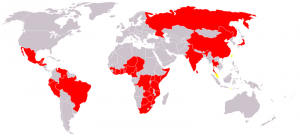The Global Sewage Problem
The Global Sewage Problem – Disease & Electricity
Disease
Every year water and sanitation problems cause more deaths than war and the lack of sanitation is the world’s biggest cause of disease. 
48% of the world’s population does not have access to adequate sewage treatment.
Many countries dispose of sewage via basic soakaways.
Soakaways provide no treatment of sewage and allow bacteria and viruses to contaminate the water table.
If a borehole is installed then the infected water will be pumped back into the drinking water and can cause illness and death.
Soakaways can cause Cholera and Typhoid infections.
Electricity
Sewage treatment plants greatly reduce the risk of disease by purifying the wastewater from a building however the treatment process relies on a constant, reliable electricity supply - a luxury that a lot of developing countries do not have, particularly in rural areas.
PodTanks has developed sewage treatment plants that do not require electricity for the treatment process. These plants can be used in areas wher there is no mains electricity available, or where the supply is erratic. Suddenly, full sewage treatment is possible anywhere in the World.
Sewage treatment plants from PodTanks the most sustainable systems available and the cheapest to run. They are the ideal solution for sewage treatment:
- PodTanks FilterPod sewage treatment plants are designed to purify sewage and wastewater naturally, using no electricity.
- They utilise gravity and natural air drafts for the treatment process, eliminating the need for electrical blowers or motors.
- The FilterPod is the most sustainable Sewage Treatment Plant available.
- As a result of its natural operation, a FilterPod is far cheaper to run than a conventional aquatic Sewage Treatment Plant.
- The bigger the treatment system the bigger the saving when using a Filter System.
Our Filter Technology
The breakdown of sewage pollutants is achieved by aerobic bacterial digestion and these bacteria must have a constant supply of oxygen in order to breathe.
The most plentiful supply of oxygen is in the air itself. At 10°C, air contains around 289 mg/L oxygen, whereas the greatest amount of dissolved oxygen possible in water at 10°C is 11 mg/L. At 10°C there is 2,566% more oxygen in air than is dissolved in water.
This is the key to why our non-electric sewage treatment plants are so efficient – they treat wastewater in air where there is more available oxygen for the pollutant digesting microbes.
There can only ever be a limited amount of oxygen in water. Conventional sewage treatment plants are full of water and therefore require a large amount of electricity to force oxygen into the water. This is usually done via the use of air blowers.
In nature, waste is broken down in the soil not in water. This is because air is able to permeate into the soil bringing with it the essential oxygen. Soil is aerobic, moist and has a large surface area (to act as a home for bacteria) making it an excellent environment for the breakdown of waste.
FilterPod treats waste in the same way as nature. The unique RDX filter media has a huge surface area and is highly absorbent to both air and water – just like soil. This creates an excellent environment for the bacteria which then feed off the pollutants in the wastewater. As the bacteria remove the pollutants the wastewater is cleaned.
To ensure a constant supply of oxygen in the RDX media FilterPod uses naturally created air drafts to continually draw air through the system and no electricity is required.